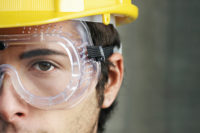Respiratory protection for workers handling engineered nanoparticles

 Each day millions of workers in the United States use National Institute for Occupational Safety and Health (NIOSH) certified respirators to reduce exposure to harmful gases, vapors, and particulate hazards. NIOSH has certification, quality assurance, and auditing procedures in place (42 CFR Part 84) that assure purchasers and users that the products they are buying/using have been tested and manufactured to strict standards. When selected, maintained and used in the context of an Occupational Safety and Health Administration (OSHA)-compliant respiratory protection program, in which personal protective technology is part of the hierarchy of controls to protect the worker, respirator users can expect that their respirator is working and reducing the amount of hazards that they could potentially breathe.
Each day millions of workers in the United States use National Institute for Occupational Safety and Health (NIOSH) certified respirators to reduce exposure to harmful gases, vapors, and particulate hazards. NIOSH has certification, quality assurance, and auditing procedures in place (42 CFR Part 84) that assure purchasers and users that the products they are buying/using have been tested and manufactured to strict standards. When selected, maintained and used in the context of an Occupational Safety and Health Administration (OSHA)-compliant respiratory protection program, in which personal protective technology is part of the hierarchy of controls to protect the worker, respirator users can expect that their respirator is working and reducing the amount of hazards that they could potentially breathe.
However, as new hazards emerge, the applicability of the science that NIOSH uses to base respirator test methods, performance requirements, and use recommendations needs to be continually reaffirmed, updated and improved to assure the expected level of protection is provided.
One such emerging hazard is engineered nanoparticles.
Engineered nanoparticles are materials with at least one dimension between 1 and 100 nanometers. Because of their distinctive physical and chemical properties, little is known about what possible health effects these properties may have on workers.
Because of these concerns, NIOSH recommends limiting worker exposures to engineered nanoparticles through standard industrial hygiene practices, including respiratory protection (when needed). Although the NIOSH recommended exposure limits (REL) for some types of nanoparticles are based on mass, particle count (number) may be a more significant concern because of their distinctive physical and chemical properties (e.g., increased surface area and reactivity).
Respirator Performance Research
While NIOSH has been certifying and conducting research for decades to assure that particulate respirators provide predictable levels of exposure reduction, engineered nanoparticles present new challenges. In particular, concerns had been raised that due to their small size, engineered nanoparticles would penetrate through respirators at higher rates than larger particles (so called "thermal rebound" effects).
Respirator Selection
The decision to use respiratory protection should be based upon professional judgment, hazard assessment, and risk management practices to keep worker inhalation exposures below an internal control or an exposure limit. NIOSH's traditional respirator selection tools apply to nanoparticles. There are several types of NIOSH certified respirators (e.g., disposable filtering facepiece, half-mask elastomeric, full facepiece, powered, airline, self-contained, etc.) that can provide different levels of expected protection to airborne particulate when used in the context of a complete respirator program.
In a survey to better understand health and safety practices in the carbonaceous nanomaterial industry, NIOSH found half-mask elastomeric particulate respirators to be the most commonly used respiratory protection followed by disposable filtering facepiece respirators. However, this application of respiratory protection appears based on subjective assessment of hazard and risk to high aspect ratio carbonaceous nanomaterials and was before the proposed NIOSH RELs for carbon nanotubes/carbon nanofibers were established.
The 2009 Approaches to Safe Nanotechnology document as well as the Current Intelligence Bulletins on titanium dioxide and carbon nanotubes contain recommendations on respirator use and selection when working with nanoparticles.
Next Steps
The research done by NIOSH to date has been done in laboratory settings using filtration test systems and manikins under aggressive test conditions. To further validate that its recommendations on respirator use against nanoparticles are optimal, further research is needed in field settings and using human test subjects. Well-designed studies on face seal leakage of nanoparticles, especially workplace protection factor (WPF) studies that validate assigned protection factor (APF) levels for respirators against nanoparticles will be important. Such studies are currently underway.
Looking for a reprint of this article?
From high-res PDFs to custom plaques, order your copy today!





